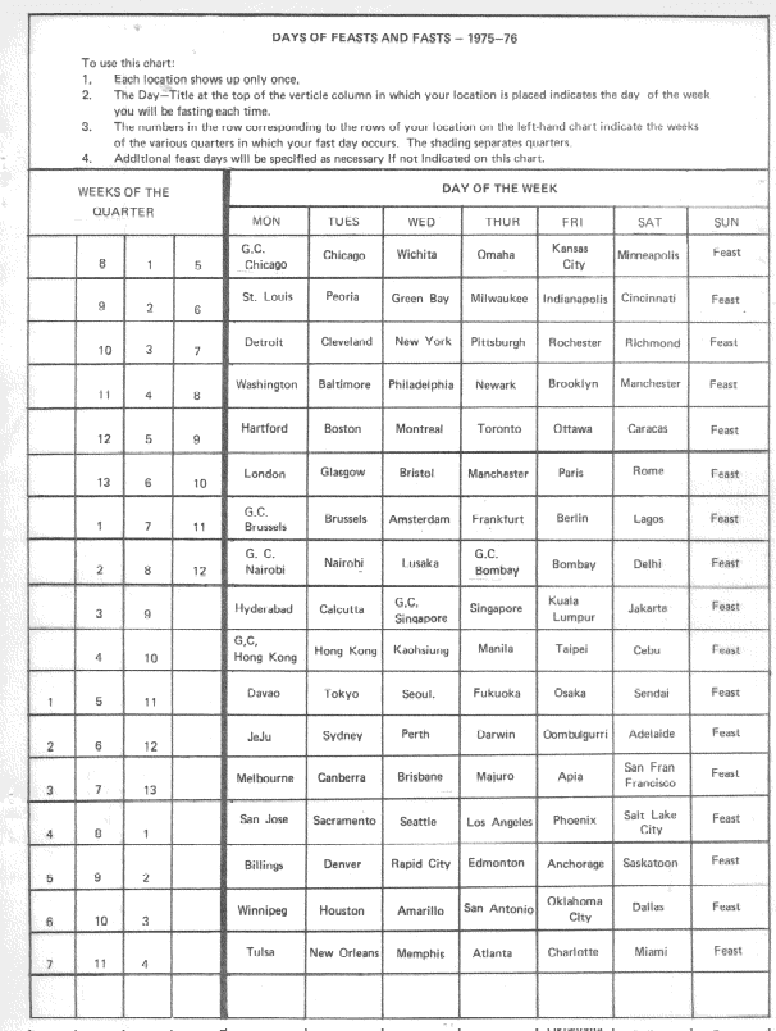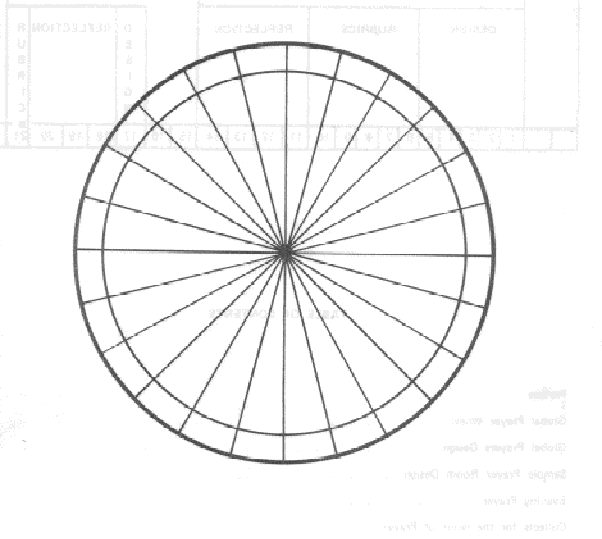

TABLE OF CONTENTS
Preface . . . . . . . . . . . . . . . . . . . . . . . . . . . . . . . . . . . . . . . . . . . . . . . . . . . . . . . . 1
Global Prayer Wheel . . . . . . . . . . . . . . . . . . . . . . . . . . . . . . . . . . . . . . . . . . . . 2
Global Prayers Design . . . . . . . . . . . . . . . . . . . . . . . . . . . . . . . . . . . . . . . . . . 4
Sample Prayer Room Design . . . . . . . . . . . . . . . . . . . . . . . . . . . . . . . . . . . . . . . . 5
Evening Prayer . . . . . . . . . . . . . . . . . . . . . . . . . . . . . . . . . . . . . . . . . . . . . . . . . . . 6
Collects for the Hour of Prayer . . . . . . . . . . . . . . . . . . . . . . . . . . . . . . . . . . 7
Psalms Lectionary . . . . . . . . . . . . . . . . . . . . . . . . . . . . . . . . . . . . . . . . . . . . . . . . 8
Intercessory Prayer Contexts . . . . . . . . . . . . . . . . . . . . . . . . . . . . . . . . . . . . . . . . 10
Reflections on Intercessory Prayer . . . . . . . . . . . . . . . . . . . . . . . . . . . . . . . . . . . . 11
Global Fast Design . . . . . . . . . . . . . . . . . . . . . . . . . . . . . . . . . . . . . . . . . . . . . . . . 17
The Fast Solitary Contexts . . . . . . . . . . . . . . . . . . . . . . . . . . . . . . . . . . . . . . . . . . 18
Days of Feasts and Fasts . . . . . . . . . . . . . . . . . . .
. . . . . . . . . . . . . . . . . . . . . . . . 21
The Order: Ecumenical has begun its Long March of service to the
world. Its comprehensive task has come clear: Depth Awareness,
Functional Eptitude, Historical Engagement, Spiritual Prowess,
and Primal Community At the heart of each of these is Profound
Consciousness in the aspects of faith, hope and love. In the year
197576, four great campaigns have been launched to strategically
accomplish the task: Global Community Forum, Global Social Demonstration,
Primal Community Experiment and Metro Cadre Circuit. The awesome
clarity on what we have to do drives one to prayer, for the alternative
is to diminish one's operating context. Prayer is the comprehensive,
concrete, practical decisionmaking that precedes every action.
As an exercise it is the dramatic rehearsal of this dynamic. In
practice, it is the placing of one's practical concerns in their
ultimate context of Being Itself.
The focus of the experiment in prayer is the recovery of intercessory prayer. Beyond its superstitious and magical perversions, intercessory prayer has always been understood by the Church to be effective. The particular aim of the experiment is the development of a contemporary form of the Angelus, a brief devotional exercise conducted at an appointed time of day marked by the sound of a bell. In Medieval times, the Angelus consisted of Ave Marias and a collect, and was done three times per day. One can imagine the Church bell sounding at the appointed times, and while the Monks did the exercise corporately, the villagers paused in their work and did the same exercise solitarily. This devotional exercise became a powerful factor in sustaining the Church's corporate impact. Recovering of the dynamic represented by the Angelus is a way of creatively addressing the issues faced by the Order in the time of social engagement.
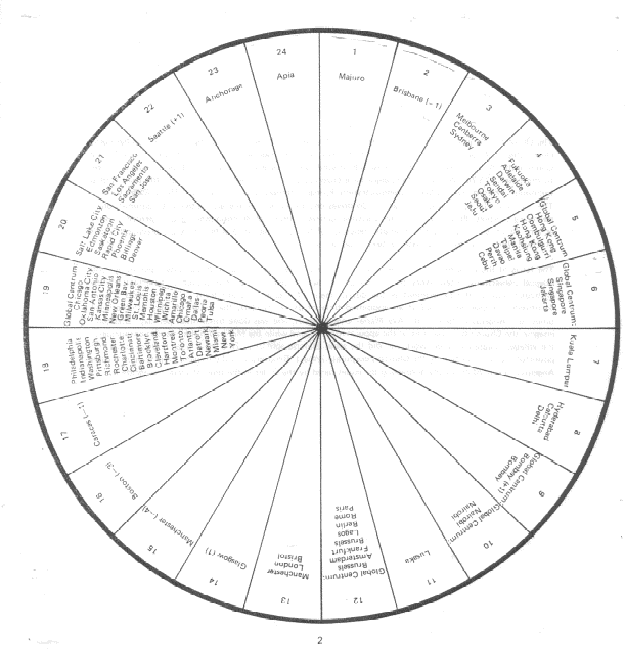 |
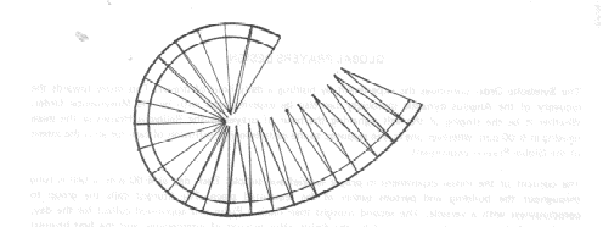 |
1. Majuro
2. Brisbane ( 1)
3. Sydney Canberra Melbourne
4. Adelaide Darwin Sendai
Tokyo Osaka Fukuoka
SeouI JeJu
5. Oombulqurri Davao Cebu
Taipei Manila Kaohsiung
Perth G.C.:Hong Kong Hong Kong
6. Singapore G.C.:Singapore Jakarta
7. Kuala Lumpur (+1)
8. Calcutta Hyderabad Delhi
9, Bombay G.C.:Bombay (+1)
10. G.C.:Nairobi Nairobi
11. Lusaka
12. Berlin Rome Frankfurt
Amsterdam Brussels Paris
Lagos G.C.:Brussels
13, London Bristol Manchester
14. Glasgow ( - I )
15. Manchester ( 4)
16. Boston ( 3)
17. Caracas ( 1) ( 1)
18, Cincinnati Indianapolis Rochester
Hartford New York Brooklyn
Montreal Newark Philadelphia
Ottawa Baltimore Washington
Richmond Toronto Pittsburgh
Miami Cleveland Detroit
Atlanta Charlotte
19. Green Bay Milwaukee Peoria
Memphis New Orleans St. Louis
Minneapolis Kansas City Houston
Omaha Tulsa Dallas
Winnipeg Wichita Oklahoma City
San Antonio Amarillo Chicago
G.C.: Chicago
20. Rapid City Denver Saskatoon
Billings Salt Lake City Phoenix
Edmonton
21. Los Angeles Sacramento San Jose
San Francisco
22. Seattle ( + 1)
23. Anchorage
24. Apia
GLOBAL PRAYERS DESIGN
The Symbolic Order continues the experiment by holding a daily
hour of prayer. This move towards the recovery of the Angelus
dynamic in society can also be experimented with by the Movemental
Order. Whether it be the ringing of the bell signalling the hour
of prayer in the Religious Houses or the mere pausing at 6:00
p.m. wherever one is, the response to the eschatological intrusion
of care for all is the intent of the Global Prayers experiment.
The content of the initial experiment in prayer is brief and simple:
Each day at 6:00 p.m. a bell is rung throughout the building and
persons gather at the appointed place. The liturgist calls the
group to consciousness with a versicle. The second liturgist then
reads a Psalm and appointed collect for the day, members of the
group who are moved by the Spirit offer prayers of intercession,
and the first liturgist offers the final prayer. The group is
then sent out with a benediction.
The following operating principles are recommended for the initial
phase of the experiment.
1) That each Religious House and Centrum Nexus perform the exercise
set forth in this manual at 6:00 p.m. local time thereby insuring
that every hour of every day someone in the Order is in prayer
over the mission;
2) that a Prayer Room be set aside for this exercise in every
location and that it be decored with appropriate representations
of the mission of sociologically loving the world;
3) that a first and second liturgist be assigned for each day
and that attendance by others be voluntary;
4) that the New Jerusalem Bible be used for the Psalm reading;
5) that the first liturgist rehearse the Psalm reading aloud before
the exercise begins;
6) that periodic reflection be held throughout the quarter and
that results be sent to Global Research Centrum, Chicago Nexus
for refinement of the corporate experiment;
7) that a "Prayer Wheel" similar to the one in this
manual become part of the decor of each Prayer Room;
8) that each collect be used for a day of the week.
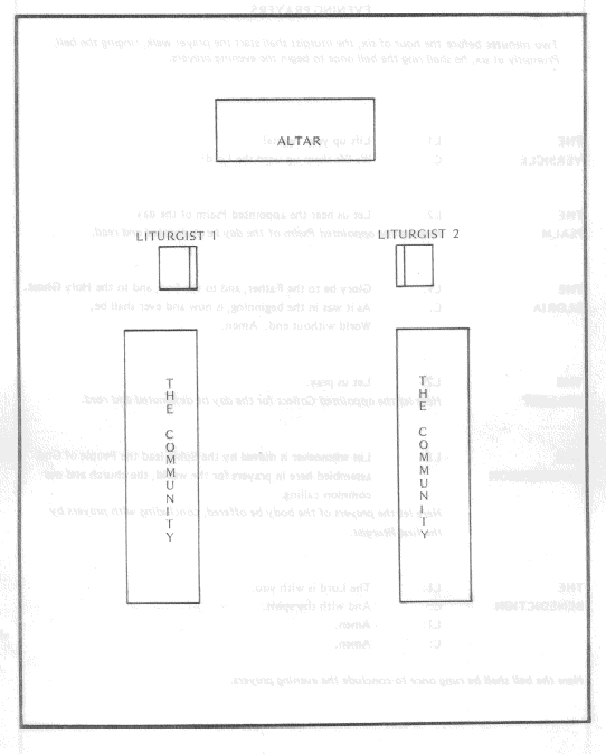 |
EVENING PRAYERS
Two minutes before the hour of six, the liturgist shall start
the prayer walk, ringing the bell. Promptly at six, he shall ring
the bell once to begin the evening prayers.
THE L1: Lift up your hearts!
VERSICLE C: We lift them up unto the Lord!
THE L2: Let us hear the appointed Psalm of the day.
PSALM Here let the appointed Psalm of the day be designated
and read.
THE L1: Glory be to the Father, and to the Son, and to the Holy Ghost.
GLORIA C: As it was in the beginning, is now and ever shall be,
World without end. Amen.
THE L2: Let us pray.
COLLECT Here let the appointed Collect for the day be designated
and read.
THE L1: Let whosoever is moved by the Spirit lead the People of God
INTERCESSION assembled here in prayers for the world, the church and our
common calling.
Here let the prayers of the body be offered, concluding with prayers by
the first liturgist.
THE L1: The Lord is with you.
BENEDICTION C: And with thy spirit.
L1: Amen.
C: Amen.
Here the bell shall be rung once to conclude the evening prayers.
GLOBAL COMMUNITY FORUM (MONDAY)
O Thou controller of the course of history, who did
give mankind the community of the globe and the companionship
of his neighbors, we pray that the Global Community Forum will
provide an authentic and effective method for the sharing of men's
concerns and the catalyzing of their care in concrete actions,
so that they may discover anew what it means to be responsible
for the future, in the name of the one who took on responsibility
for all mankind, even Jesus Christ our Lord. Amen.
METRO CADRE (TUESDAY)
O Thou mighty one who sends thy people into all the
world to make disciples of all nations, we pray for the emergence
of metro cadres around the globe that effective form may be given
to the longings of all mankind to participate in building the
new form of human society, in the name of Jesus Christ our Lord.
Amen.
PRIMAL COMMUNITY EXPERIMENT (WEDNESDAY)
O God who in thy mysterious providence led our fathers
to form communities to sustain and humanize solitary souls, grant
that the Primal Community Experiment as it serves the local suffering
of mankind, may hold in dynamic tension the communal wisdom of
the past and the global beckonings of the future that all men
may grasp their present destiny as the sons of God, in the name
of Him who pioneered the role of Sonship for all mankind, even
Jesus Christ our Lord. Amen.
HISTORIC CHURCH (THURSDAY)
O Thou who has had thy people in every age and place,
we pray for the role of the historic church in the 20th century
that it may become the transparent sign of Those Who Care authentically
and effectively embodying service to all men, in the name of Jesus
Christ our Lord. Amen.
GLOBAL SOCIAL DEMONSTRATION (FRIDAY)
O Thou all powerful presence through whom all miracles
are possible, grant the building of reconstructed local communities
in Majuro, Oombulgurri, JeJuDo, Taj Gunj, Kawangware, Trastavere,
Isle of Dogs, City Five as places where the fullness of men's
lives is affirmed and engaged on behalf of their whole earthly
home, that ever hereafter men having seen those signs can mold
and employ the many structures of society for responsible service
to men of every condition, in the name of the one who pioneered
in radical demonstration of love of God and neighbor, even Jesus
Christ our Lord. Amen.
COUNCIL '76 (SATURDAY)
O Thou merciful and everlasting God who has throughout
history called together thy people to discern thy will and give
form to that new direction, grant, we beseech thee, that Global
Council 1976 be a sign of the church gathered caring for the needs
of the world as recreated community so that effective methodologies
for releasing the profoundly human element in every situation
might be shared with all people. We ask this in the name of Jesus
Christ our Lord. Amen.
TRAINING (SUNDAY)
O giver and destroyer of life who calls all men to
the searing care of one another, we pray for the intuitive wisdom
necessary to create the nurturing forms of priorship training,
so that through the discipline of obedience to such forms we may
rise to the gigantic task of leadership in our tumultuous world,
in the name of the Son of life who showed what all men could do,
even Jesus Christ our Lord. Amen.
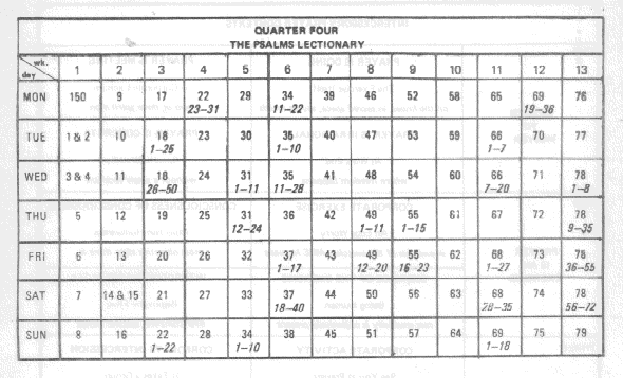 |
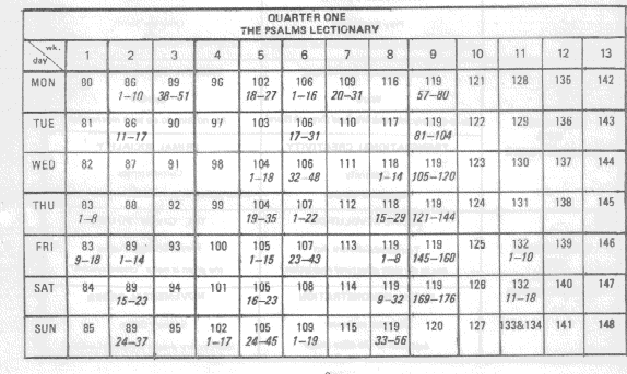 |
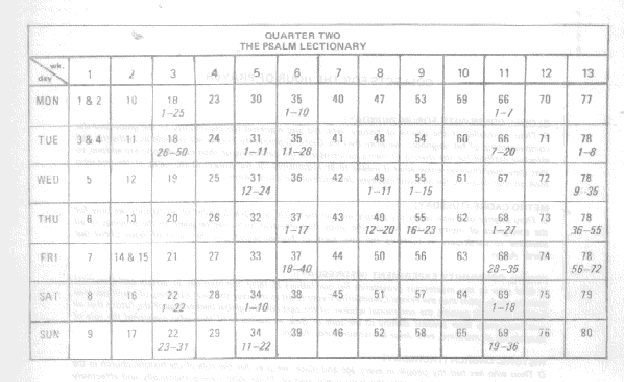 |
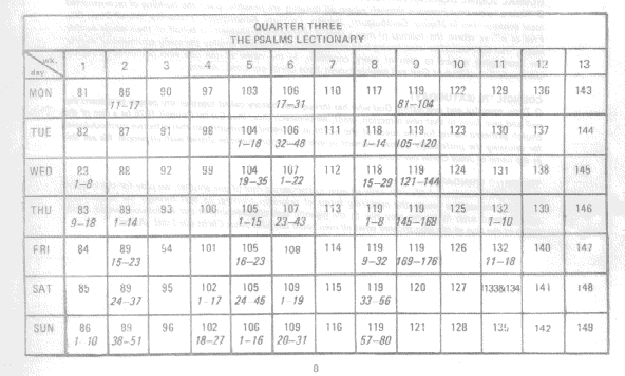 |
INTERCESSORY PRAYER CONTEXTS
| ONE RETURN |
|
|
| TO
PRAYER |
|
|
| TWO PRAYER |
|
|
| IS AN
EXERCISE |
|
|
| THREE
INTERCESSORY PRAYER |
|
|
| FOUR AWARENESS |
|
|
| OF A
STRANGE POWER |
|
|
| FIVE INTERCESSION |
|
|
| AND SOCIAL
DEMONSTRATION |
|
|
Since prayers and Intercessions for health belong to the normal intercourse between man and God, it is difficult to draw a sharp boundary line between Spiritdetermined and magical praying. Generally speaking, one can say that a Spirit determined prayer seeks to bring one's own personal center, including one's concern for the health of one's self or of someone else, before God, and that it is willing to accept the divine acceptance of the prayer whether its overt content is fulfilled or not. Conversely, a prayer which is only a magical concentration on the desired aim, using God for its realization, does not accept an unfulfilled prayer as an accepted prayer, for the ultimate aim in the magic prayer is not God and the reunion with him but the object of the prayer, for example, health. A prayer for health in faith is not an attempt at faith healing but an expression of the state of being grasped by the Spiritual Presence.
Paul Tillich, Systematic Theology, 111; p. 279f.
. . . every serious prayer produces something new in terms of creaturely freedom which is taken into consideration in the whole of God's directing creativity, as is every act of man's centered self. This newness, created by the prayer of supplication, is the spiritual act of elevating the content of one's wishes and hopes into the Spiritual Presence. A prayer in which this happens is "heard", even if subsequent events contradict the manifest content of the prayer. The same is true of prayers of intercession which not only produce a new relation to those for whom the prayer is made but also introduce a change in the relation to the ultimate of the subjects and objects of intercession.
Paul Tillich, Systematic Theology, 111; p. 191
God's directing creativity is the answer to the question of the meaning of prayer, especially prayers of supplication and prayers of intercession. Neither type of prayer can mean that God is expected to acquiesce in interfering with existential conditions. Both mean that God is asked to direct the given situation toward fulfillment. The prayers are an element in this situation, a most powerful factor if they are true prayers. As an element in the situation a prayer is a condition of God's directing creativity, but the form of this creativity may be the complete rejection of the manifest contort of the prayer. Nevertheless, the prayer may have been heard according to its hidden content, which is the surrender of a fragment of existence to God. This hidden content is always decisive. It is the element in the situation which is used by God's directing creativity. Every serious prayer contains power, not because of the intensity of desire expressed in it, but because of the faith the person has in God's directing activity-a faith which transforms the existential situation.
Paul Tillich, Systematic Theology, 1; p. 267
The right provision which it befits the Church to have of what
will be salutary for it in its coexistence with the world naturally
becomes Prayer.
As the consciousness of the Church thus moves to and fro between
the present and the future, it enters in a twofold way into
combination with the God consciousness. In view of the fact that
every success attained is due not solely to its own activities
but also to the divine government of the world, it becomes thankfulness
or resignation for what in the present is the outcome of previous
exertions, according as the average result of human effort is
surpassed (thankfulness) or unachieved (resignation}. But for
that which still remains undecided it becomes prayer-i.e., the
inner combination with the Godconsciousness of a wish for
full success....
But the mind of man (ever anticipating as it does the temporal
development of things) is unable to refrain from painting what
is possible in a variety of imaginative pictures and comparing
their values for its own projects, or from coming to cling by
preference to those from which it expects most advantage; and
as long as this mental activity lasts, it is bound to combine
with the Godconsciousness and become prayer. This is always
going on, so that we have no cause to regard the injunction to
pray without ceasing as hyperbole. If we did not pray, that could
only be due to a disappearance either of our interest in the Kingdom
of God, which evokes these ideas of an advantageous but uncertain
future, or of our God consciousness, which keeps present to our
mind the absolute powers of the divine world government…
.
. . . the Church's duty is first to reconcile the uncertain elements
of prevision (so far as they may be discordant) which flow from
the imperfect common consciousness of individuals, and then to
appease the feeling of uncertainty through the gathering together
of individuals for common prayer; for through the very form of
common religious action each individual feels himself be drawn
away from what is more personal in origin to that which could
be the same in all, and is guided by the content and meaning of
such common action to that which lays hold on all equally. . .
So far, then, it is true that every prayer is prayer in Jesus'
name where the petition (whatever it be) is offered with reference
to the Kingdom of God. But the more definite the prayer is, the
more necessary it becomes that its object should be conceived
of as in agreement with the order according to which Christ rules
His Church, so that the person who prays may as such be regarded
as a true and acceptable representative of Christ. It follows
that none can be true prayer in Jesus' name except that which
springs from the self- consciousness of the Church as a whole,
i.e., such prayer as in its content keeps the whole condition
of the Church in view. Prayer of this kind certainly belongs to
the common prayer of the Church at any given moment, and that
such prayer is heard it is impossible to doubt. If the Church's
need has been rightly apprehended, and if the dominating presentiment
has arisen out of the Church's whose consciousness of its own
inner condition and outward circumstances, then the prayer is
charged with full truth: it represents Christ's knowledge of His
spiritual body and defines His ruling activity. Hence, in view
of the power received by the Son from the Father, its content
cannot but be fulfilled. Every other prayer, springing from a
less perfect Church consciousness, even though it touch equally
Christ's concerns and arise from a sincere endeavor to act in
His spirit, can look for fulfillment only in the measure in which
it harmonizes with the normative prayer as just described; indeed,
it is only thus far that it ought to claim fulfillment. Such prayer,
accordingly, can only gain confidence by subordinating itself
to prayer that is normative and seeking to be heard only on that
condition....
But between prayer and its fulfillment there exists a connexion
due to the fact that both things have of one and the same foundation,
namely the nature of the Kingdom of God. In that Kingdom the two
are one-prayer as Christian presentiment growing out of
the whole action and influence of the divine Spirit, and fulfillment
as expressive of Christ's ruling activity in relation to the same
object. Seen thus, fulfillment would not have arrived in the development
of the Kingdom of God on which the fulfillment must follow. But
fulfillment does not come because prayer was offered (as though
prayer could here be regarded isolatedly as a cause in itself),
but because the right prayer can have no other object than what
is in line with the divine goodpleasure. Neither would it
have come, in virtue of the divine decree, even had there been
no prayer {as though the divine decree bore upon particulars apart
from their natural nexus); it comes because of the inward state
that gives rise to prayer itself forms part of the conditions
under which it was possible for the result effectually to emerge....
Right prayer only arises when we are engaged in the activities that go to fulfill our Christian vocation. Thus every true moment of prayer rests on a moment or element of action, so that prayer cannot destroy action without being itself destroyed; on the other hand, the presentiment expressed in such prayer as originates otherwise is bound to be purely arbitrary, and can carry with it no certainty whatever that it is in harmony with the ruling activity of Christ. No more can action destroy prayer, for action of such a kind could not be directed upon the Kingdom of God. The agent is readily satisfied with what he himself can achieve; and such action could give no guarantee of its being under the influence of Christ's rule.
Friedrich Schleiermacher, The Christian Faith, II, Pp.
668-674
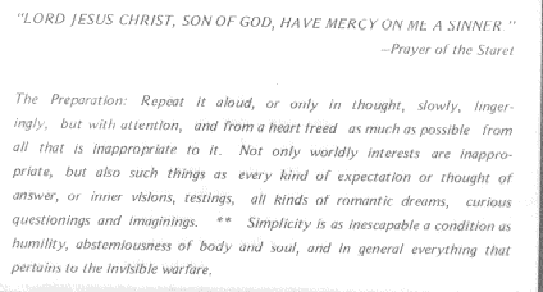 |
Fasting is an exercise of the spirit and is a symbol of a decision
to do a deed. Therefore the act of fasting is radically practical,
and the rubric is clear liquids only for 24 hours. Each House
in preparation for its fast day will corporately reflect on what
the fast is about and over. The contextual framework within which
the exercise takes place allows the full depth of the experience
to happen, so sensitivity to each day of the House's fasting and
the necessary contextual statements are required.
Each House will maintain a notice board that indicates which House
is fasting on behalf of the whole Order that particular day. Feast
days could be marked by the same board.
On the Fast day the "nomeals" would be celebrated
corporately using the normal meal structures, with the exception
of silence being substituted for "Let us feast."
I. Fasting is an experiment in the experience of
spiritual poverty, designed as a corporate rehearsal of the state
of detachment. We have attempted to recover the monastic vows
of poverty, chastity and obedience, taking the traditional practice
of fasting as the mark of those who selfconsciously participate
in that promise. In the church, it is grasped solely as a missional
index of those who have decided to corporately be the People of
God in history.
II. Fasting is the intentional, symbolic withdrawal
of a people for the purpose of total engagement. But, man is both
fascinated by the call of complete expenditure and fearful of
losing himself in that same process. He seeks security, therefore,
by attaching himself to instinctual behavior. To the degree one
is attached to anything other than that which is unsynonomous
with any other thing, one reduces that part of life into an unliving,
a dead, object. Fasting, however, has nothing to do with reality;
but, rather, is symbolic, not of whether you possess much or little,
but of the stance of nonchalance relative to "abounding or
abasing".
III. In the fast, one is confronted with one's own
personal contingency. The frailty of human existence seen as ever
close and real. In fact, the drive to posit oneself in time seems
to be itself a Herculean struggle. In one's mind, all images pass
away. One has to muster every sensation to grasp his awareness
of life at all. This is the human experience of bottomless concern
for life. It is this driving care for life that undergirds the
spirit for building societies.
IV. To dramatize this basic posture, fastin3 becomes
a literal sign of concern for men. it is a ritual act that points
beyond itself in the representational sense. Fasting becomes a
means of grace whereby all men participate in and through the
fast.
V. Primitive man fasted when, with fire and tools,
he was able to break the 24hour search for food. His preoccupation
with things was broken as fewer hours were needed for actual procurement.
This breakthrough itself signified the dawn of consciousness which
separated man from beast.
VI. The ancient church tradition of fasting has its
roots in just such a recollection. She has used the calendar to
remind both herself and all of civilization in an intentional
way that consciousness of consciousness is fought for. And the
great Feast Days always followed the fast, in which the breakfast
was as important as the fasting. In fact, all of one's conscious
life can be understood in terms of a rhythm of fasting and feasting.
VII. Fasting as a community practice has its precedent
in most world religions. These serve as times of deep reflection
when a whole group steps back from the frenzy of life and re-appropriates
its own uniqueness and significance. This is experienced as a
healing time for the community. Without the pause of detachment,
our engagement lacks intentionality and creativity.
VIII. The feast is the exodus from the fast. But
it has within it the paradox of the desert. While it is a return
to the bounties of life, it is a return to feast on the spirit.
It is a celebration of the journey from unconsciousness to consciousness
of consciousness. The fast has given us the possibility to feast
forever in grace.
IX. The fast is built on a human dynamic. Take, for
example, the experience around noontide, when, during a day the
tedium results in lassitude and indifference. Yet, the craving
for food grinds away. When we pull back, we see that our body
drives on in spite of our indifference.
X. The spirit within is really what is slothful and
vacant. The growling within is symbolic of the inner pertubation
that is constantly going on in our spirit. We are driven to seek
others but fall back on our own disquietude. We continue to work
with this strange rumbling within.
XI. Amid this double occurrence, we find ourselves
able to stand outside of ourselves and observe with penetrating
lucidity our own life action. Perhaps it is more like levitating
the body as it seems to float around the room looking at what
is going on. It is as if whatever happens, one can perceive it
intently. There is sheer delight in apprehending and having the
event apprehending you in every sense as you live the occasion.
XII. Fasting is always relative to a temporal concern
as it comes out of a concrete situation. But, the purpose of fasting
is to discern the actual situation and not just the superficial
manifestations. One sees the situation as if through it, in order
to expose or "smoke out" the real nature of the contradiction.
One takes a second look and calls out or names the one block or
points to that which requires his total effort.
XIII. Directly after his baptism, Jesus went into
the desert for a fortyday fast. The images he had of himself
on high places, turning rocks into bread or seated on Caesar's
throne were fantasies with which he had to struggle. These three
temptations were personified in the one image of Satan. Over against
these contentions, he remained loyal to his calling to be the
Son of God.
XIV. Jesus' disciples were chided for not fasting
enough. Jesus replied that the bridegroom is always present, therefore
the fast must be decisional, not mechanically religious. One always
fasts within the Word and feasts on it continually, thereby has
permission to take into himself all of the suffering of mankind.
XV. The intense awareness of one's own contingency
prefigures the deathly encounter with Satan. As one's sense of
time fades, the present hour intensifies one's own sensitivity.
All of one's struggle and guilt relative to his own life becomes
focused. And one realizes his only tempter is the rebellious Satanic
force itself. The only decision one must struggle with, is the
struggle to be faithful to one's own calling.
XVI. Jesus left the fast in the desert full of the
Holy Spirit. He now went forth to preach the message of the good
news that the kingdom of God is at hand and is available to all.
The realization of the other world was his one mission. It was
here in our midst, and now there Is only one temptation. That
is the temptation not to embody the posture of both worlds.
We have been concerned with the intensification of
interior discipline that will be life or deat1i to the movement
over the 20 year march. The wearing of the cross as a sign of
chastity, the night watch as a sign of obedience, and now the
Fast as a sign of poverty are three ways we are experimenting
with recovering corporate vows, or the interiorizing of corporateness.
The Fast has to do with spiritual detachment, the intentional
withdrawal from life's many attachments in order to be free to
follow the Word. More than the previous two exercises, the Fast
confronts the participant with his own fraility and contingency,
causing images of significance to fade, and throwing him upon
the only unending concern-the mystery of life and death. Thus
the Fast gives external indication of the final commitment, the
decision to travel the whole distance.
As we trace the historical journey of the Fast and
the Feast, we have to begin with the dawn of consciousness of
man, when the animal activity of taking in sustenance was selfconsciously
developed into a pattern of fasting and feasting. That doubtlessly
exploded the gift of the meal within the community. The Church
further discovered the formation tool of the Fast as training
in spirit discipline; at the same time she appropriated the feast
in the calendar as a major celebrative event. It was understood
that a man engaging in a Fast as a religious exercise cast out
demons, particularly the one of attachment, unblocking him in
the freedom of his spirit to be creative intentionality. A Fast
was marked by the return to feasting, which now becomes a radical
embracing of the bounty of life.
The experience of the Fast is unique to each person,
but wisdom from previous fasts indicates that certain dynamics
can be expected. The absence of meals will disrupt the day's rhythm
resulting in hunger pang, at strange times, tedium, and a physical
lassitude. One's spirit vascillates between deep restlessness
and a vacant slothfulness in the midst of the corporate missional
thrust. The senses are intensified; in experiences ranging from
penetrating lucidity to euphoria or passionate engagement. Critical
in the entire experience is the awareness of the double occasion
of the Fast; over a temporal, particular reality in history
and about the eternal or one's relation to final mystery.
The scriptures describe fully the context within
which fasting goes on. There is the story of Jesus in the desert
as the most obvious example of the effects, the temptations, and
the decision in the experience of the Fast. Jesus stands as the
Word which gives permission to selfconsciously fast or feast
on behalf of all of suffering mankind. He related fasting to the
casting out of demons when he pointed out to his disciples that
"some demons can be cast out only by prayer and fasting."
Also, the resurrectional life is portrayed through the imagery
of the feasting on the other side of the fast-the risen Christ
breaks bread and eats fish, though as the dead one he needs no
food. Finally, he ascends to prepare places for all the disciples
at the eternal feasting on the Spirit that goes on in the Other
World in the midst of this world.
-from Global Research Assembly, 1972
The more frequently one fasts the more crucial it
is to prepare for it. That is why celebration together just preceding
the fast is most important. It prepares us to go on the fast together.
But one must personally prepare himself. This means something
like doing a homily for one's self before beginning the fast or
early in it.
It is a glory to me that this fast comes during the
emphasis on the Mountain of Care. In the River of Consciousness
the bridegroom was with us. Not so in the Mountain of Care. He
has gone away that we may learn that he is with us always. When
you go to the mountain you are left all alone. This enables the
detachment necessary to lift the mountain. The fast is the detachment
for Golgotha, for the Mountain of Care.
The detachment from food is a sign of my detachment
from temporality. The desire for food is probably the most basic,
foundational propensity of man. Fast from food is a symbol of
detachment from everything else, that is every other propensity
of man. In our day it is hard for us to grasp just how basic the
propensity for food is, when we live in a culture of such affluence.
There have been moments in history when this propensity has driven
men to the eating of one another in the midst of tragic circumstance,
when a group would have to decide which in their midst would die
so that the others might live.
